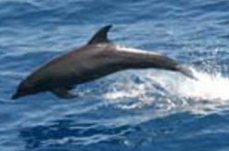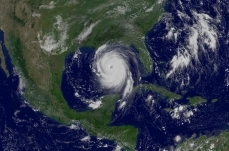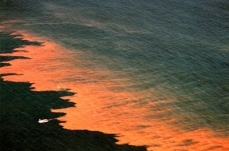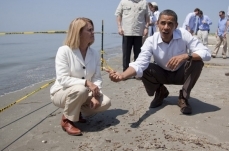Oil in the Marine Environment (main)
From The Encyclopedia of Earth
Oil in the Marine Environment
Worldwide, about 210 million gallons of petroleum enter the sea each year from the extraction, transportation, and consumption of crude oil and the products refined from it. Most of that petroleum comes from land-based runoff, polluted rivers, airplanes, and small boats and jet skis. Smaller amounts come from accidental spills from oil tankers and platforms. Another an additional 180 million gallons enters the ocean from natural seeps. Large oil spills can be devastating to the marine environment. They kill fish, mammals, birds, and their offspring; destroy plant life; and reduce the food supply for organisms that survive. Spills also disrupt the structure and function of marine communities and ecosystems.
-
 Featured Article
Featured Article  Oil Drilling Environmental Health ConcernsThis article, written by Charles W. Schmidt1, appeared first in Environmental Health Perspectives—the peer-reviewed, open access journal of the National Institute of... More »
Oil Drilling Environmental Health ConcernsThis article, written by Charles W. Schmidt1, appeared first in Environmental Health Perspectives—the peer-reviewed, open access journal of the National Institute of... More »
-
 Featured Article
Featured Article  Deepwater Horizon Oil Spill and Marine MammalsThe Deepwater Horizon Oil Spill and Marine Mammals Marine Mammals at Risk in the Gulf of Mexico Stock assessment reports compiled by the National Marine Fisheries Service... More »
Deepwater Horizon Oil Spill and Marine MammalsThe Deepwater Horizon Oil Spill and Marine Mammals Marine Mammals at Risk in the Gulf of Mexico Stock assessment reports compiled by the National Marine Fisheries Service... More »
-
 Featured Article
Featured Article  Hurricanes and the Gulf of Mexico oil spillMost hurricanes span an enormous area of the ocean (200-300 miles) — far wider than the current size of the spill. If the slick remains small in comparison to a typical... More »
Hurricanes and the Gulf of Mexico oil spillMost hurricanes span an enormous area of the ocean (200-300 miles) — far wider than the current size of the spill. If the slick remains small in comparison to a typical... More »
-
 Featured Video SoLa: Lousiana water stories (1:46)Date of Video: Jul 2, 2010 Everywhere you look in Southern Louisiana (SoLa) there’s water – bayous, swamps, the Mississippi River, the Gulf of Mexico. And everyone... More »
Featured Video SoLa: Lousiana water stories (1:46)Date of Video: Jul 2, 2010 Everywhere you look in Southern Louisiana (SoLa) there’s water – bayous, swamps, the Mississippi River, the Gulf of Mexico. And everyone... More »
-
 Featured Article
Featured Article  Distinguishing oil spills from algal bloomsWhen observed from a boat or aircraft, many kinds of natural phenomena can be mistaken for oil on the water surface. Kelp beds, accumulations of jellyfish, and cloud shadows on... More »
Distinguishing oil spills from algal bloomsWhen observed from a boat or aircraft, many kinds of natural phenomena can be mistaken for oil on the water surface. Kelp beds, accumulations of jellyfish, and cloud shadows on... More »
-
 Featured Article
Featured Article  Tarballs (Oil in the Marine Environment)A tarball is a blob of petroleum that has been weathered after floating in the ocean. When crude oil (or a heavier refined product) floats on the ocean surface, its physical... More »
Tarballs (Oil in the Marine Environment)A tarball is a blob of petroleum that has been weathered after floating in the ocean. When crude oil (or a heavier refined product) floats on the ocean surface, its physical... More »
Recently Updated
 Oil Drilling Environmental Health Concerns Last Updated on 2014-11-29 21:42:39 This article, written by Charles W. Schmidt1, appeared first in Environmental Health Perspectives—the peer-reviewed, open access journal of the National Institute of Environmental Health Sciences The article is a verbatim version of the original and is not available for edits or additions by Encyclopedia of Earth editors or authors. Companion articles on the same topic that are editable may exist within the Encyclopedia of Earth. As Royal Dutch Shell and other oil companies prepare to drill offshore in the Alaskan Outer Continental Shelf (OCS), a new report commissioned by the Washington, DC–based Pew Environment Group concludes current response capabilities aren’t adequate to contain and clean up a major spill in the area.1 Marilyn Heiman, who directs the group’s U.S. Arctic program, says drilling on the Alaskan OCS requires a science-based... More »
Oil Drilling Environmental Health Concerns Last Updated on 2014-11-29 21:42:39 This article, written by Charles W. Schmidt1, appeared first in Environmental Health Perspectives—the peer-reviewed, open access journal of the National Institute of Environmental Health Sciences The article is a verbatim version of the original and is not available for edits or additions by Encyclopedia of Earth editors or authors. Companion articles on the same topic that are editable may exist within the Encyclopedia of Earth. As Royal Dutch Shell and other oil companies prepare to drill offshore in the Alaskan Outer Continental Shelf (OCS), a new report commissioned by the Washington, DC–based Pew Environment Group concludes current response capabilities aren’t adequate to contain and clean up a major spill in the area.1 Marilyn Heiman, who directs the group’s U.S. Arctic program, says drilling on the Alaskan OCS requires a science-based... More »  Pinniped (Oil in the Marine Environment) Last Updated on 2014-07-21 17:04:25 Pinnipeds ("finned-feet") are are group of marine mammals, that includes seals, sea lions, and walruses. The word pinniped is sometimes treated as a synonym for "seal" since all pinnipeds except for the the sole species of Walrus are seals (sea lions are eared seals). Scientific Classification Kingdom: Animalia (Animals) Phylum:--- Chordata Class:------ Mammalia (Mammals) Order:-------- Carnivora (Carnivores) Family:-------- Otariidae (Eared seals) Pinnipeds differ form other marine mammals like whales, dolphins and porpoises in that they do not spend their entire lives in water. Pinnipeds "haul out" onto land and ice to mate, give birth, moult, and rest. Pinnipeds were agressively hunted until the early twentieth century for their skins, oil, meat and, in the case of... More »
Pinniped (Oil in the Marine Environment) Last Updated on 2014-07-21 17:04:25 Pinnipeds ("finned-feet") are are group of marine mammals, that includes seals, sea lions, and walruses. The word pinniped is sometimes treated as a synonym for "seal" since all pinnipeds except for the the sole species of Walrus are seals (sea lions are eared seals). Scientific Classification Kingdom: Animalia (Animals) Phylum:--- Chordata Class:------ Mammalia (Mammals) Order:-------- Carnivora (Carnivores) Family:-------- Otariidae (Eared seals) Pinnipeds differ form other marine mammals like whales, dolphins and porpoises in that they do not spend their entire lives in water. Pinnipeds "haul out" onto land and ice to mate, give birth, moult, and rest. Pinnipeds were agressively hunted until the early twentieth century for their skins, oil, meat and, in the case of... More »  Arctic offshore oil exploration spill response planning Last Updated on 2012-05-11 00:00:00 Worldwide, oil and gas companies are being forced by resource declines to drill in less accessible areas, and the Arctic is their newest frontier. This article, written by Charles W. Schmidt*, appeared first in Environmental Health Perspectives—the peer-reviewed, open access journal of the National Institute of Environmental Health Sciences. The article is a verbatim version of the original and is not available for edits or additions by Encyclopedia of Earth editors or authors. Companion articles on the same topic that are editable may exist within the Encyclopedia of Earth. Offshore Exploration in the Arctic: Can Shell’s Oil-Spill Response Plans Keep Up? All around the world, oil and gas companies are being forced by resource declines to drill in less accessible areas, and the Arctic is their newest frontier. The geology above the Arctic... More »
Arctic offshore oil exploration spill response planning Last Updated on 2012-05-11 00:00:00 Worldwide, oil and gas companies are being forced by resource declines to drill in less accessible areas, and the Arctic is their newest frontier. This article, written by Charles W. Schmidt*, appeared first in Environmental Health Perspectives—the peer-reviewed, open access journal of the National Institute of Environmental Health Sciences. The article is a verbatim version of the original and is not available for edits or additions by Encyclopedia of Earth editors or authors. Companion articles on the same topic that are editable may exist within the Encyclopedia of Earth. Offshore Exploration in the Arctic: Can Shell’s Oil-Spill Response Plans Keep Up? All around the world, oil and gas companies are being forced by resource declines to drill in less accessible areas, and the Arctic is their newest frontier. The geology above the Arctic... More »  API oil-water separator Last Updated on 2012-03-07 00:00:00 An API oil-water separator is a device designed to separate gross amounts of oil and suspended solids from the wastewater effluents of petroleum refineries, petrochemical and chemical plants, natural gas processing plants and other industrial sources. The name is derived from the fact that such separators are designed according to standards published by the American Petroleum Institute (API).[1][2] Description of the design and operation The API separator is a gravitative separation device designed by using Stokes' Law to define the rise velocity of oil droplets based on their size and density. The design of the separator is based on the density difference between the oil and the wastewater because that difference is much smaller than the specific gravity difference between the suspended solids and water. Based on that design criterion, most of the suspended solids... More »
API oil-water separator Last Updated on 2012-03-07 00:00:00 An API oil-water separator is a device designed to separate gross amounts of oil and suspended solids from the wastewater effluents of petroleum refineries, petrochemical and chemical plants, natural gas processing plants and other industrial sources. The name is derived from the fact that such separators are designed according to standards published by the American Petroleum Institute (API).[1][2] Description of the design and operation The API separator is a gravitative separation device designed by using Stokes' Law to define the rise velocity of oil droplets based on their size and density. The design of the separator is based on the density difference between the oil and the wastewater because that difference is much smaller than the specific gravity difference between the suspended solids and water. Based on that design criterion, most of the suspended solids... More » Olivia's birds and the oil spill Last Updated on 2012-01-03 19:19:57 Taken from Young Voices for the Planet, "Olivia's Birds and the Oil Spill" documents 11-year old Olivia Bouler's deep connection with the natural world, in particular, with the Gulf of Mexico, and how her love of birds drove her to create 500 bird paintings to raise $200,000 for Audubon's efforts to rescue birds after the BP Oil spill. Olivia goes further and visits congressmen and the Secretary of the Interior with her message: no offshore oil drilling, get off fossil fuels and invest in renewable energy. Her message resonates with the media and reaches millions of people around the world. She receives many fan letters including one from Bill Clinton. More »